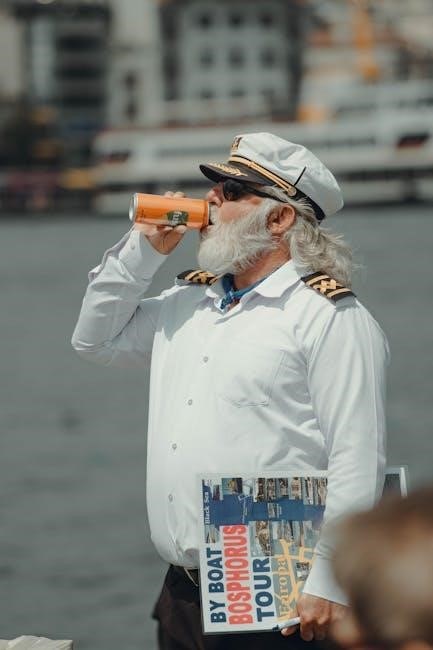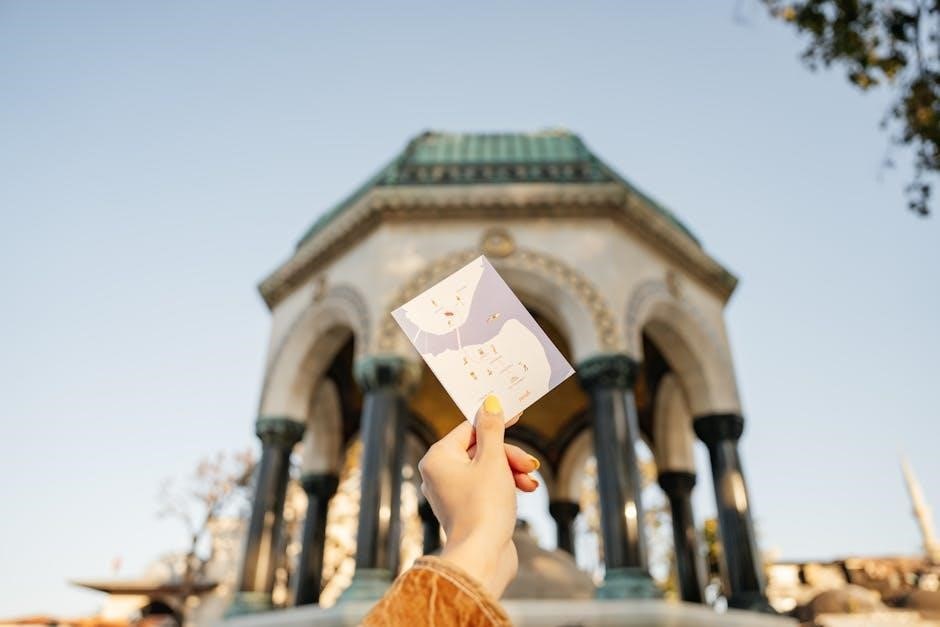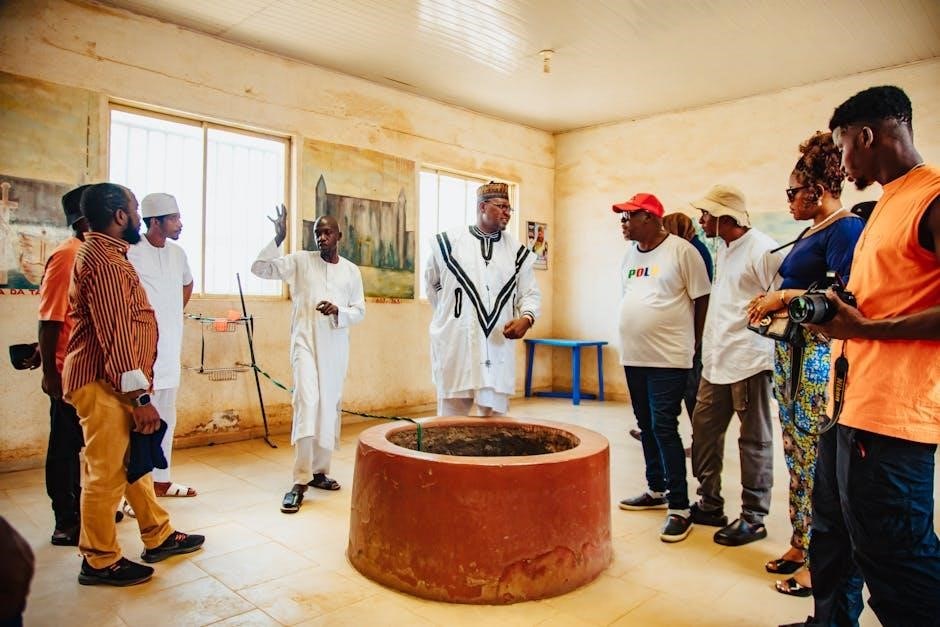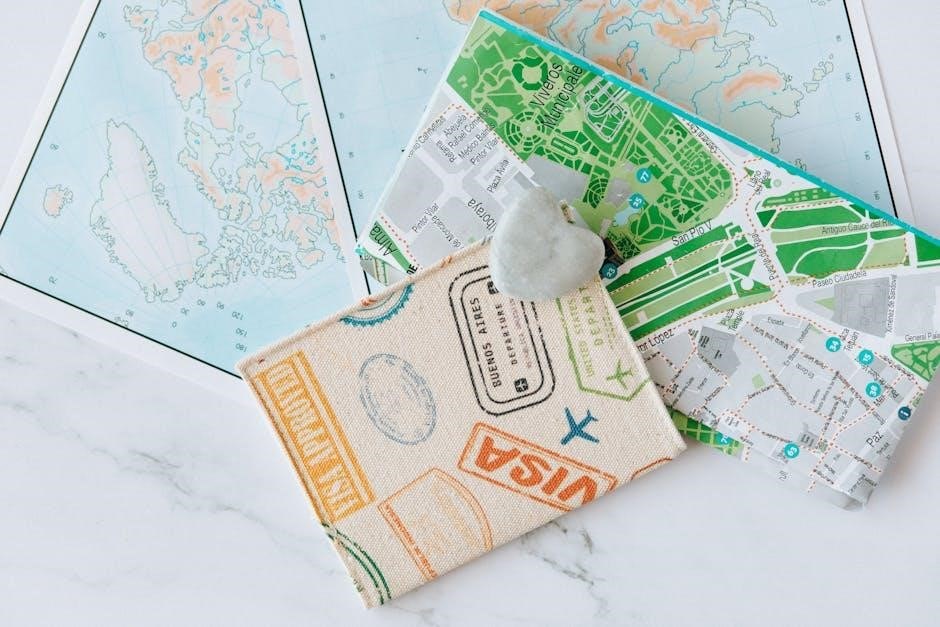The Philippines is an archipelago in Southeast Asia, known for its stunning beaches, vibrant culture, and warm hospitality․ Rich history and biodiversity make it a unique destination․
1․1 Overview of the Philippines
The Philippines is an archipelago in Southeast Asia, comprising over 7,000 islands․ Known for its rich biodiversity, it is home to lush rainforests, vibrant coral reefs, and diverse wildlife․ The country has a population of over 100 million, with a mix of indigenous, Spanish, and American cultural influences․ Filipinos are renowned for their hospitality and warm smiles; The Philippines is a melting pot of traditions, languages, and landscapes, making it a unique and captivating destination for travelers․ Its strategic location on the Pacific Ring of Fire contributes to its dramatic geography and occasional natural phenomena like typhoons and earthquakes․
1․2 Geography and Climate
The Philippines is an archipelago of over 7,000 islands in Southeast Asia, bordered by the Pacific Ocean to the east and the South China Sea to the west․ Its diverse geography includes volcanic mountains, lush forests, and extensive coastlines․ The climate is tropical, with two main seasons: dry (December to May) and wet (June to November)․ Typhoons frequently occur during the wet season․ The islands boast stunning beaches, coral reefs, and biodiversity hotspots, making the Philippines a paradise for nature lovers and adventure seekers․ Its unique geography creates a variety of ecosystems and landscapes․

Best Places to Visit
The Philippines offers diverse destinations, from Palawan’s stunning beaches to Boracay’s vibrant nightlife, Cebu’s historical sites, Manila’s cultural landmarks, and Baguio’s cool mountain retreats, perfect for exploration․
2․1 Top Destinations in the Philippines
The Philippines boasts a variety of iconic destinations that cater to all types of travelers․ Palawan, renowned for its pristine beaches and crystal-clear waters, is a must-visit, with El Nido and Coron being top choices․ Boracay, famous for its vibrant nightlife and White Beach, attracts millions yearly․ Cebu, a mix of history and nature, offers Magellan’s Cross and the stunning Kawasan Falls․ Manila, the bustling capital, showcases Intramuros and museums, while Baguio provides a cool retreat with Burnham Park and scenic views․ Each destination highlights the Philippines’ diverse beauty and culture․
2․2 Manila: The Capital City
Manila, the bustling capital of the Philippines, is a melting pot of history, culture, and modernity․ Intramuros, the historic walled city, features landmarks like Fort Santiago and San Agustin Church․ The city is also home to vibrant markets, such as Divisoria, and the lively streets of Binondo, the world’s oldest Chinatown․ Manila offers a mix of colonial architecture, cultural museums, and contemporary attractions, making it a must-visit for both history enthusiasts and urban explorers․ Its dynamic energy reflects the heart of the Philippines’ rich heritage and urban lifestyle․
2․3 Boracay: The Beach Paradise
Boracay, a tiny island in the Philippines, is renowned for its pristine beaches and vibrant nightlife․ White Beach, with its powdery sand and crystal-clear waters, is a tropical paradise․ The island offers a variety of activities, including snorkeling, diving, and sunset cruises․ Its lively bars and restaurants make it a popular destination for both relaxation and entertainment․ Despite its small size, Boracay has a big reputation as one of the world’s most beautiful beaches, attracting visitors from across the globe․ Its charm and beauty create an unforgettable island experience․
2․4 Palawan: The Hidden Gem
Palawan, often called the “Last Frontier,” is a tropical haven known for its untouched beaches, crystal-clear lagoons, and lush forests․ El Nido’s towering limestone cliffs and Coron’s pristine lakes are must-visit spots․ The Underground River, a UNESCO World Heritage Site, offers a unique glimpse into natural wonders․ Palawan’s diverse marine life makes it a paradise for snorkeling and diving․ With its serene atmosphere and breathtaking landscapes, Palawan captivates travelers seeking adventure and tranquility․ Its unspoiled beauty has earned it a reputation as one of the world’s most stunning destinations․
2․5 Cebu: The Queen City of the South
Cebu, known as the “Queen City of the South,” is a vibrant destination blending rich history and modern charm․ Home to iconic landmarks like Magellan’s Cross and the Basilica del Santo Niño, it showcases the Philippines’ deep Catholic roots․ The nearby islands of Badian and Moalboal offer thrilling adventures, from canyoneering to diving with sardine runs․ Cebu’s cultural festivals, such as the Sinulog, and its mouthwatering lechon make it a must-visit․ Its mix of heritage, nature, and lively atmosphere captivates every traveler․
2․6 Baguio: The Summer Capital
Baguio, known as the “Summer Capital of the Philippines,” is a cool mountain retreat offering a refreshing escape from tropical heat․ Famous for its lush parks, such as Burnham Park, and the stunning Botanical Garden, the city is a haven for nature lovers․ Visit the iconic Mines View Park for breathtaking views or explore the Ifugao Woodcarvers’ Village to experience indigenous culture․ Don’t miss the vibrant Strawberry Farm, where you can pick fresh strawberries․ Baguio’s unique blend of natural beauty and cultural charm makes it a must-visit destination․

Cultural and Historical Attractions
The Philippines offers a rich tapestry of cultural and historical attractions, from vibrant festivals to ancient landmarks and museums showcasing its Spanish colonial past and indigenous traditions․
3․1 Festivals and Celebrations
The Philippines is renowned for its vibrant festivals, showcasing its rich culture and faith․ The Sinulog Festival in Cebu and Ati-Atihan in Kalibo highlight colorful parades and street dancing, celebrating history and religion․ These events reflect the country’s deep traditions and lively spirit, attracting both locals and tourists․ Each festival offers a unique glimpse into the nation’s heritage, blending music, dance, and costumes․ The Philippines’ festive atmosphere is truly unforgettable, making it a must-experience destination for cultural enthusiasts․
3․2 Historical Landmarks
The Philippines is home to numerous historical landmarks that reflect its rich and diverse past․ Intramuros, a walled city in Manila, showcases Spanish colonial architecture and history․ Fort Santiago and Barasoain Church are iconic sites, with the latter known as the birthplace of the First Philippine Republic․ The Chocolate Hills and Mayon Volcano are natural wonders that highlight the country’s geological heritage․ Magellan’s Cross in Cebu symbolizes the arrival of Christianity․ These landmarks provide a glimpse into the Philippines’ cultural and historical journey, offering a blend of history, religion, and natural beauty․
3․3 Museums and Galleries
The Philippines boasts a variety of museums and galleries that celebrate its cultural and artistic heritage․ The National Museum Complex in Manila houses the National Museum of Fine Arts, Anthropology, and Natural History, showcasing Filipino art and historical artifacts․ The Ayala Museum in Makati offers insights into the country’s history and culture through interactive exhibits․ The Pinto Art Museum in Antipolo highlights contemporary Filipino art in a stunning architectural setting․ These institutions provide a deeper understanding of the Philippines’ rich cultural and artistic legacy, making them must-visit destinations for travelers․
3․4 Cultural Villages
Cultural villages in the Philippines offer immersive experiences into the country’s heritage and traditions․ Places like Las Casas Filipinas de Acuzar and the Taal Heritage Village showcase traditional Filipino architecture and lifestyle․ Visitors can explore historic houses, witness cultural performances, and engage in local crafts․ These villages provide a unique opportunity to connect with the Philippines’ rich cultural identity and understand its historical roots․ They serve as living museums, preserving the nation’s customs and traditions for future generations to appreciate and enjoy․

Adventure and Outdoor Activities
The Philippines is a paradise for adventure seekers, offering snorkeling, diving, hiking, surfing, and caving․ Its lush mountains and stunning beaches provide endless opportunities for outdoor exploration and thrilling experiences․
4․1 Hiking and Trekking
The Philippines offers diverse hiking and trekking opportunities, from lush forests to volcanic landscapes․ Popular spots include Mount Pulag, known for its stunning sunrise views, and Mount Taal, featuring a unique crater lake․ The challenging trails of the Cordillera Mountains and the scenic routes of Palawan cater to both beginners and experienced hikers․ These adventures provide breathtaking vistas, immersive cultural experiences, and encounters with rich biodiversity․ Hiking in the Philippines is a perfect blend of nature, culture, and adventure, making it a must-try for outdoor enthusiasts visiting the islands․
4․2 Scuba Diving and Snorkeling
The Philippines is a paradise for scuba diving and snorkeling enthusiasts, boasting vibrant coral reefs and diverse marine life․ Tubbataha Reefs Natural Park, a UNESCO World Heritage Site, offers breathtaking underwater landscapes․ El Nido and Coron in Palawan are famous for their crystal-clear waters and stunning limestone formations․ Dive sites like Moalboal and Anilao attract both experienced divers and beginners․ With its rich biodiversity, including manta rays, whale sharks, and colorful fish, the Philippines provides unforgettable underwater experiences․ Its warm waters and excellent visibility make it a top destination for marine adventurers․
4․3 Surfing and Water Sports
The Philippines is a haven for surfing and water sports enthusiasts․ Siargao, known as the “Surfing Capital of the Philippines,” offers world-class waves at Cloud 9, attracting surfers globally․ Baler and La Union are other top destinations for catching waves․ Beyond surfing, visitors can enjoy kayaking, paddleboarding, and jet-skiing in destinations like Boracay and Cebu․ The clear waters and vibrant marine life make these activities unforgettable․ Whether you’re a novice or an experienced adventurer, the Philippines’ diverse water sports cater to all levels, ensuring an exhilarating experience amidst stunning natural beauty․
4․4 Caving and Spelunking
The Philippines offers thrilling caving and spelunking adventures, with its lush landscapes and unique geological formations․ Sagada is famous for its caves and hanging coffins, while Puerto Princesa Subterranean River in Palawan is a UNESCO World Heritage site, featuring an underground river․ Adventure seekers can explore vast cave systems in Cebu, with stunning rock formations․ These destinations provide unforgettable experiences, combining nature, history, and adventure, making the Philippines a must-visit for spelunking enthusiasts․

Food and Nightlife
Filipino cuisine offers a rich blend of flavors, with dishes like adobo and lechon․ Vibrant nightlife in cities like Manila and Cebu features bars, clubs, and live music․
5․1 Filipino Cuisine
Filipino cuisine is a vibrant fusion of Spanish, Chinese, and Malay flavors․ Popular dishes include adobo, a savory stew, and lechon, a whole roasted pig․ Sinigang, a sour soup, and pancit, noodle dishes, are also favorites․ The cuisine often features fresh seafood, coconut milk, and spices․ Street food like balut (fertilized duck egg) and lumpia (spring rolls) offers a taste of local culture․ Filipino meals are hearty, flavorful, and deeply rooted in tradition, making the country a food lover’s paradise with endless culinary delights to explore․
5․2 Street Food Markets
Philippine street food markets offer a vibrant culinary experience, showcasing local flavors at affordable prices․ Popular spots like Manila’s Quiapo and Boracay’s Night Market feature dishes such as balut (fertilized duck eggs), isaw (grilled chicken intestines), and lumpia (spring rolls)․ These markets are hubs of activity, blending the aromas of grilled meats, fresh seafood, and sweet treats like halo-halo․ They provide a authentic taste of Filipino culture, attracting both locals and tourists eager to explore the country’s diverse street food scene․
5․3 Nightlife in Major Cities
The Philippines’ major cities offer a lively nightlife scene, blending modern bars, clubs, and lounges with local culture․ Manila’s Makati and Bonifacio Global City are hotspots for upscale bars and rooftop lounges, while P․ Burgos Street in Makati is famous for its vibrant party atmosphere․ Cebu’s Mango Avenue and IT Park host a mix of bars and clubs, catering to both locals and tourists․ Boracay’s White Beach is renowned for its beachside parties and live music․ The nightlife in these cities is diverse, offering something for every taste and preference, from cozy pubs to energetic dance floors․

Travel Tips
Planning ahead, researching destinations, using reliable transportation, booking safe accommodations, budgeting wisely, learning basic Filipino phrases, and respecting local customs ensure a smooth and enjoyable journey․
6․1 Getting There
The Philippines is accessible via major international airports like Ninoy Aquino International Airport (NAIA) in Manila and Mactan-Cebu International Airport․ Flights from global hubs connect to these key entry points․ Major airlines such as Philippine Airlines and Cebu Pacific offer direct and connecting routes․ Travelers can book flights in advance for better deals, using platforms like Google Flights or Skyscanner․ The Philippines is also a transit hub in Southeast Asia, making it easy to reach from nearby countries․ Plan ahead, compare options, and secure your tickets early for a hassle-free journey․
6․2 Transportation Options
The Philippines offers diverse transportation options for travelers․ Jeepneys and taxis are widely available for short trips, while buses connect major cities․ Ride-hailing apps like Grab are popular in urban areas․ Ferries and boats are essential for island hopping, especially to destinations like Palawan and Cebu․ Renting a car or motorbike provides flexibility for exploring rural areas․ In provinces, tricycles and habal-habal (motorcycle taxis) are common․ For convenience, consider booking transfers through hotels or tour operators․ Plan ahead, as transportation options may vary between urban and provincial areas․
6․3 Accommodation Choices
The Philippines offers a wide range of accommodation options to suit all budgets and preferences․ Luxury resorts and high-end hotels cater to travelers seeking comfort and modern amenities, while budget-friendly guesthouses, hostels, and inns provide affordable stays․ Beachfront cottages and eco-lodges are ideal for nature lovers, offering unique experiences․ Homestays and Airbnb options are also popular, allowing visitors to immerse in local culture․ Major cities like Manila and Cebu have a mix of upscale and mid-range hotels, while destinations like Palawan and Siargao boast boutique resorts․ Always book in advance, especially during peak seasons․
6․4 Safety and Precautions
Exercise high caution in the Philippines due to risks of terrorism and violent crime․ Avoid carrying large amounts of cash and use reputable transportation services․ Petty theft and scams are common in crowded areas and public transport․ Stay informed about local conditions, especially in Mindanao and the Sulu Archipelago, where risks are higher․ Follow local authorities’ advice and avoid traveling to unsafe zones․ Most tourist areas, like Palawan and Boracay, are generally safe, but remain vigilant․ Respect local customs and avoid displaying valuables to ensure a secure and enjoyable trip․
6;5 Budgeting and Costs
The Philippines is a budget-friendly destination, offering affordable accommodations, meals, and activities․ Daily expenses can range from $20 to $50 for budget travelers, while mid-range travelers may spend $50 to $100․ Luxury options are also available at higher costs․ Meals start from $3 to $10, and local transportation is inexpensive․ Budgeting extra for island hopping, diving, or entrance fees to attractions is advisable․ Prices may vary depending on location and season․ Plan ahead and allocate funds wisely to enjoy a cost-effective and memorable trip․
6․6 Language and Communication
English is widely spoken in the Philippines, making communication easy for tourists․ Filipino (Tagalog) is the national language, but most locals, especially in tourist areas, speak English fluently․ Regional dialects like Cebuano and Ilocano are also common․ Learning basic Tagalog phrases can enhance your experience and show respect for the culture․ Signage and menus are often in English, and guides are readily available․ Effective communication ensures a smooth and enjoyable trip, allowing visitors to fully immerse in the local culture and lifestyle․

Local Customs and Etiquette
Respect for elders is deeply rooted in Filipino culture․ Removing shoes before entering homes or churches is customary․ Using utensils while dining is expected, and polite greetings are appreciated․
7․1 Respect for Culture
Respecting Filipino culture is essential for a harmonious visit․ Filipinos value hospitality and modesty, so dressing appropriately, especially in churches or homes, is appreciated․ Removing shoes before entering homes or traditional spaces is customary․ Using both hands when giving or receiving items shows respect․ Polite greetings like “po” and “opo” are customary when speaking to elders․ Public displays of affection are generally reserved, and loud behavior in quiet areas should be avoided․ Understanding these customs fosters positive interactions and cultural appreciation during your stay․
7․2 Dress Code and Behavior
Dressing modestly is key in the Philippines, especially when visiting churches or attending cultural events․ Revealing clothing may draw unwanted attention or offend locals․ In mosques or traditional areas, cover your shoulders and knees․ Public behavior should be respectful; avoid loud noises or overly casual attire in formal settings․ Removing shoes before entering homes or certain cultural sites is customary․ Using both hands when giving or receiving items is a sign of respect․ These practices ensure a courteous and enjoyable interaction with Filipino culture and traditions․
7․3 Tipping and Gratuity
Tipping in the Philippines is not mandatory but is widely appreciated for good service․ For restaurants, bars, and hotels, 10-20 pesos or 10% of the total bill is customary․ Tour guides, drivers, and porters also benefit from tips, typically 50-100 pesos per day․ When using services like tricycle rides or small shops, spare change or rounding up the fare is a kind gesture․ Tipping reflects gratitude and enhances the service experience, though it’s optional based on satisfaction․

Nature and Wildlife
The Philippines boasts rich biodiversity, featuring lush rainforests, coral reefs, and endemic species like the Philippine eagle․ National parks and wildlife reserves offer stunning natural experiences․
8․1 National Parks
The Philippines is home to numerous national parks, each showcasing its unique biodiversity and natural beauty․ Notable parks include the Chocolate Hills in Bohol, featuring over 1,000 conical hills, and Mayon Volcano in Bicol, known for its perfect cone shape․ These parks offer breathtaking landscapes, diverse wildlife, and opportunities for hiking, birdwatching, and eco-tourism․ They are vital for conservation and provide a glimpse into the country’s rich natural heritage, making them must-visit destinations for nature enthusiasts and adventurers alike․
8․2 Wildlife Reserves
The Philippines boasts several wildlife reserves that protect its rich biodiversity․ Tubbataha Reefs Natural Park, a UNESCO World Heritage Site, is renowned for its vibrant marine life and coral reefs․ The Philippine Eagle Sanctuary in Davao safeguards the critically endangered Philippine Eagle, the country’s national bird․ These reserves provide habitats for diverse flora and fauna, including marine turtles, whale sharks, and tropical birds․ They play a crucial role in conservation efforts and offer unique opportunities for eco-tourism and wildlife exploration, attracting nature enthusiasts and researchers alike․
8․3 Birdwatching Spots
The Philippines is a paradise for birdwatchers, with over 700 species documented․ Key spots include Subic Bay, known for its rainforest habitat, and Candaba Wetlands in Pampanga, a haven for migratory birds․ The Veranda Nature Park in Cagayan Valley and Las Piñas-Parañaque Wetland Park near Manila are also notable․ These sites offer glimpses of rare species like the Philippine Eagle-Owl and Black-banded Flycatcher․ Birdwatching tours often include expert guides, making it an unforgettable experience for enthusiasts and casual observers alike․
Itinerary Suggestions
The Philippines offers diverse itineraries, combining Manila’s historical sites, Boracay’s beaches, Palawan’s landscapes, Cebu’s cultural heritage, and Baguio’s mountain retreats for unforgettable travel experiences․
9․1 7-Day Itinerary
A 7-day Philippines tour offers a mix of culture, adventure, and relaxation․ Day 1: Arrive in Manila, explore Intramuros, and visit Binondo․ Day 2: Fly to Boracay, enjoy White Beach, and experience nightlife․ Day 3: Relax in Boracay, snorkel, or try water sports․ Day 4: Travel to Palawan, visit Underground River․ Day 5: Island-hop in El Nido, explore lagoons․ Day 6: Discover Coron’s lakes and reefs․ Day 7: Return to Manila, visit museums, and depart․ This itinerary balances history, nature, and leisure․
9․2 14-Day Itinerary
A 14-day Philippines tour allows for a deeper exploration of its islands․ Days 1-3: Manila and nearby Pagsanjan Falls․ Days 4-6: Boracay for beaches and water activities․ Days 7-9: Palawan, including El Nido’s island hopping and the Underground River․ Days 10-12: Cebu, with visits to Chocolate Hills, Tumalog Falls, and Oslob’s whale sharks․ Days 13-14: Baguio for cool weather and scenic views․ This extended itinerary offers a mix of culture, adventure, and relaxation, giving travelers a comprehensive experience of the Philippines’ diverse beauty and heritage․

Essential Information
The Philippines offers quality healthcare in major cities, with modern facilities and English-speaking staff․ Emergency services are accessible, and visa requirements vary by nationality․ Exercise caution and research local conditions for a safe trip․
10․1 Healthcare and Medical Facilities
The Philippines has a mix of public and private healthcare facilities․ Private hospitals in major cities like Manila and Cebu offer high-quality care with English-speaking staff, catering to tourists․ Public facilities are more affordable but may lack modern equipment․ It’s advisable to have travel insurance to cover medical expenses, as private healthcare can be costly․ Rural areas often have limited access to advanced care, so visitors should take precautions and stay informed about local health conditions․ Emergency services are accessible, and knowing contact numbers is crucial for immediate assistance․
10․2 Emergency Contacts
In the Philippines, key emergency numbers include 911 for general emergencies, 117 for citizen complaints, and 112 for national emergency services․ Tourists can also contact the Philippine National Police (PNP) or the Bureau of Fire Protection (BFP) directly․ For medical emergencies, private hospitals in major cities have 24/7 hotlines․ It’s advisable to save these numbers and know the location of the nearest hospital or police station․ Additionally, the Department of Tourism provides assistance to visitors through their tourist assistance desks located in airports and major tourist spots․
10․3 Visa Requirements
Visa requirements for the Philippines vary by nationality․ Citizens of many countries, including the U․S․, Canada, and European nations, can receive a visa on arrival valid for 30 or 59 days․ Others may need to apply in advance․ Requirements typically include a valid passport, return ticket, and proof of funds․ Long-term visas, such as the Balikbayan privilege for former residents, are also available․ Check the Philippine Immigration website for the latest regulations, as requirements can change․ Ensure all documents are up-to-date before traveling to avoid entry issues․

Tips for Responsible Travel
Respect local customs, minimize waste, and support eco-friendly activities․ Choose sustainable tours and conserve natural resources to preserve the Philippines’ beauty for future generations․ Travel responsibly and mindfully․
11․1 Eco-Tourism
Eco-tourism in the Philippines focuses on sustainable practices, preserving natural wonders, and supporting local communities․ Choose eco-friendly accommodations, participate in environmentally responsible activities, and respect wildlife habitats․ Avoid single-use plastics, conserve water, and refrain from touching or damaging coral reefs․ By embracing eco-tourism, you contribute to the conservation of the Philippines’ rich biodiversity and support eco-conscious initiatives that benefit both the environment and local economies․ Responsible travel ensures the beauty of the Philippines is preserved for future generations to enjoy․
11․2 Supporting Local Communities
Supporting local communities in the Philippines enriches your travel experience while contributing to their livelihoods․ Engage with local artisans, purchase handicrafts, and dine at family-owned restaurants․ Use local tour guides and transportation services to directly benefit residents․ Respect cultural traditions and interact with locals in a mindful, respectful manner․ Your support fosters economic growth and helps preserve cultural heritage, ensuring a positive impact on the communities you visit․ This approach promotes sustainable tourism and strengthens the bond between visitors and locals․
11․3 Reducing Plastic Use
Reducing plastic use is crucial for preserving the Philippines’ stunning natural beauty and marine life․ Bring reusable water bottles, bags, and containers to minimize waste․ Refuse single-use plastics, such as straws and cutlery, and opt for eco-friendly alternatives․ Support local businesses that promote sustainable practices․ Properly dispose of trash and participate in beach cleanups if possible․ By taking these steps, you help protect the environment and contribute to a greener future for the Philippines․ Every small action makes a positive impact on this beautiful archipelago․
